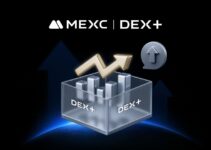
As high-risk financial instruments, cryptocurrencies have grown in popularity and now it’s becoming mainstream commodities, and traders are drawn to their highly volatile price swings.
On the other side, Forex (foreign currency exchange) is a high-risk investment, but its price changes are far more steady than crypto. Currency exchange rates generally move less sharply.
Aside from price volatility, there are differences between forex and cryptocurrency. This post will compare the two categories of assets.
What is The Difference Between Crypto and Forex?
While forex and cryptocurrencies both involve the exchange of assets, their definitions and underlying assets differ.
Forex, which stands for foreign exchange, focuses on the trading of traditional fiat currencies issued by sovereign governments.
Cryptocurrencies, on the other hand, are decentralized digital assets that, in many cases, use blockchain technology to function as alternate mediums of trade and storage.
What separates forex from cryptocurrencies? Several fundamental factors between these two asset groups.
1. Volatility
Price volatility is a key difference between forex and cryptocurrency markets. Cryptocurrencies are known for their extreme price swings.
For example, Bitcoin surged to a peak of $73,000 before dropping to around $30,000, then falling further to $15,000, and later rebounding to $30,000. Many other cryptocurrencies experience even more drastic fluctuations.
In contrast, forex markets generally exhibit more stable price changes. Major price movements are often limited to exotic currency pairs and are usually triggered by significant economic shocks. This stability allows for more precise risk management.
However, while the volatility in cryptocurrency markets increases risk, it also offers the potential for substantial rewards.
2. Fundamental
The approaches used to assess the forex and cryptocurrency markets differ greatly. Forex traders use fundamental research to assess a country’s economic health and predict currency value movements.
Political climate and events have a substantial impact on exchange rate dynamics. In contrast, the fundamental study of cryptocurrencies is focused on the asset’s intrinsic value.
The utility of a cryptocurrency, the rate of user acceptance, and the strength of its development team are all important factors in determining its potential value.
3. Profit
Both the forex and cryptocurrency markets provide opportunities to profit from price changes, but the possible profits differ dramatically.
Cryptocurrencies are well-known for their ability to create significant returns, frequently in multiples of the initial investment. In comparison, forex returns are typically modest.
Beyond ordinary buying and selling, the cryptocurrency market offers a variety of earning opportunities, including mining, airdrops, staking, and lending.
Forex trading, on the other hand, is primarily based on benefitting from price differences between purchasing and selling currencies. Foreign exchange trading has the potential to generate considerable returns, particularly when leverage is used.
4. Risk
The axiom “higher risk, higher reward” applies to both forex and cryptocurrency trading. Cryptocurrencies, known for their volatility, can face sudden and significant price drops. Furthermore, fundamental project flaws can result in near-total value degradation.
While FX markets are often more stable, there is a common misunderstanding that they are less dangerous. Forex trading involves major hazards, although these dangers differ from those found in cryptocurrency markets.
Forex traders are more concerned with the risks of leverage than with big price drops. Leverage is a financial technique that can increase both earnings and losses. Miscalculations while using leverage can lead to significant financial losses.
As a result of the multiplying effect of leverage, the risk of loss in forex trading is higher than in bitcoin trading.
5. Regulatory
The regulatory monitoring of FX and cryptocurrency markets differs significantly. Most governments establish strict rules on forex trading, which ensures market integrity and investor protection.
In contrast, the regulatory environment for cryptocurrencies is marked by a patchwork of methods. While some countries have put in place full regulatory frameworks, others remain neutral, and a small number have outright prohibited cryptocurrency activity.
This gap in governmental regulation complicates the landscape for investors and businesses working in cryptocurrencies.
6. Security
Forex and cryptocurrency trading face unique security problems.
In forex, the main risk is adverse price changes leading to financial losses, but central bank backing adds stability and reduces the likelihood of fraud.
Cryptocurrency investments face broader security risks. Alongside price volatility, investors are vulnerable to scams and fraudulent projects, where irresponsible developers can create worthless assets. The decentralized nature of crypto also makes recovering stolen funds more challenging.
While forex benefits from a controlled framework, both forex and cryptocurrency trading include counterparty risk, which means investors must trust brokers or exchanges. As a result, due research is vital when choosing a trading platform in either market.
7. Liquidity
Liquidity is a significant difference between forex and cryptocurrency markets. Forex enjoys much higher liquidity, with daily trading volumes of more than $7 trillion in 2021 and a market capitalization of around $2 quadrillion in 2021.
In comparison, the crypto market has lower liquidity, with daily trading volumes generally between $100 billion and $200 billion. During the peak bull run in May 2021, volumes reached $500 billion, and the market capitalization was $2.91 trillion.
Forex’s higher liquidity facilitates easier execution of large trades at desired prices. Conversely, while major cryptocurrencies like Bitcoin and Ethereum are relatively liquid, trading smaller or less well-known crypto assets can be more challenging and less predictable.
Conclusion
The forex and cryptocurrency markets, while both offering opportunities for profit, diverge significantly in terms of volatility, fundamentals, profit potential, risk, regulation, security, and liquidity.
Forex, a more established market, provides stability and accessibility but with generally lower returns. Cryptocurrencies, on the other hand, present a high-risk, high-reward environment with rapid price fluctuations and regulatory uncertainties.
Now, understanding these key differences is crucial for investors seeking to navigate these dynamic markets. The choice between forex and cryptocurrency trading depends on individual risk tolerance, investment goals, and market knowledge.
Personal Note From MEXC Team
Check out our MEXC trading page and find out what we have to offer! There are also a ton of interesting articles to get you up to speed with the crypto world. Lastly, join our MEXC Creators project and share your opinion about everything crypto! Happy trading! Learn about interoperability now!
Join MEXC and Get up to $10,000 Bonus!



